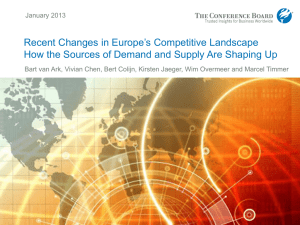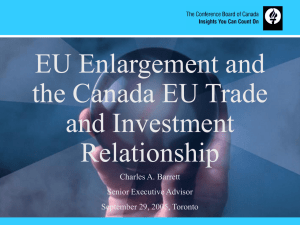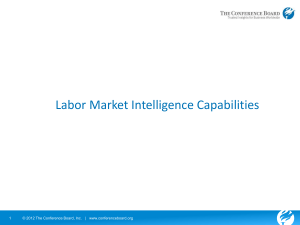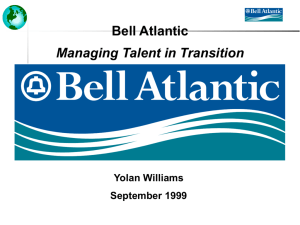Talent Management
advertisement
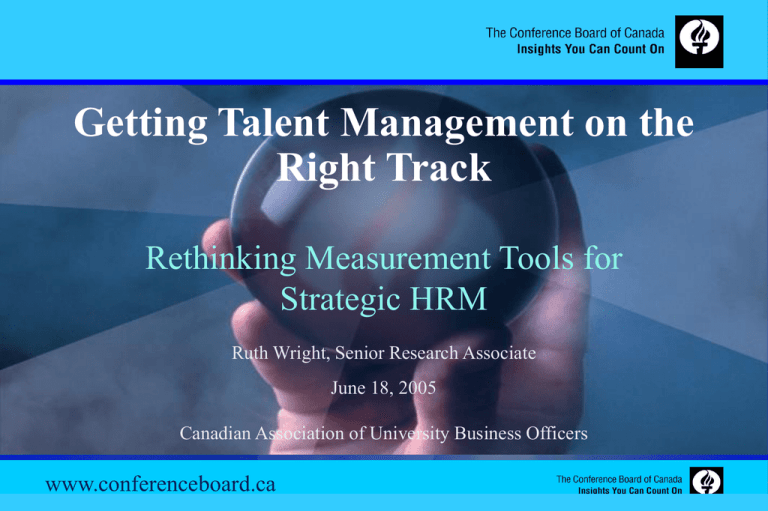
Getting Talent Management on the Right Track Rethinking Measurement Tools for Strategic HRM Ruth Wright, Senior Research Associate June 18, 2005 Canadian Association of University Business Officers The Conference Board of Canada www.conferenceboard.ca Session Outline Background—Measuring HR Effectiveness Working Group What is Talent Management? Approaches to measurement – limitations, challenges, opportunities – an alternative approach Measuring key people drivers of performance – an engaged workforce – effective leadership – strategy and processes to manage talent The Conference Board of Canada www.conferenceboard.ca Session Objective To provide perspective and stimulate thinking about Talent Management and measurement in the university context The Conference Board of Canada www.conferenceboard.ca The Journey The Working Group On Measuring Human Resource Effectiveness Project Objective To identify and develop together, select measures tied to Human Resources drivers of organizational performance. The Conference Board of Canada www.conferenceboard.ca Working Group on Measuring Human Resources Effectiveness Atomic Energy of Canada Canada Customs & Revenue Agency Canadian Pacific Railway Government of Ontario Hallmark Canada Hydro One Inc. Imperial Oil The Conference Board of Canada www.conferenceboard.ca Department of National Defense Ontario Power Generation Petro-Canada Rogers Communication SaskEnergy Incorporated Sears Canada Inc. Treasury Board of Canada Selecting HC Drivers of Firm Performance Where can we get the biggest “bang” for our human capital investment dollars? – key drivers will be organization and sector specific – however, there are some universal drivers of human capital value The Conference Board of Canada www.conferenceboard.ca The Crucial Three… The Working Group on Human Resources Effectiveness picked three to explore: an “engaged” workforce effective leaders strategy and processes to manage talent The Conference Board of Canada www.conferenceboard.ca Talent Management “Building human capital at all levels of the organization will be the primary factor in growth and organizational excellence.” David Ulrich, University of Michigan The Conference Board of Canada www.conferenceboard.ca What is Talent Management? “A popular and prevalent phrase” whose meaning “is still somewhat fuzzy” – The Conference Board Inc. Integrated and Integrative Talent Management “The term is now used like confetti” – Lance Berger Executive Excellence Definitions range from a narrow focus on top talent to a broader set of integrated and aligned initiatives designed to build workforce capacity overall The Conference Board of Canada www.conferenceboard.ca What Is It? Definitions “Talent” are those people you want to keep. TM is a comprehensive and dynamic process of building the talent pool through the development of aligned and integrated processes, practices and shared accountabilities by leaders around the human resource fundamentals of attraction, selection, development and retention of talent. Source: Working Group on Measuring Human Resources Effectiveness The Conference Board of Canada www.conferenceboard.ca Talent Management... Begins with defining the “business”…no matter whether that is serving the public or manufacturing automobiles Then creating and aligning the organization’s strategic human resource plan and all peoplerelated practices to the strategic direction of the business The Conference Board of Canada www.conferenceboard.ca Characteristics of a Successful Talent Management Organization Development mindset Performance culture Focus on “linchpin” positions Senior leadership team champions talent – devote time to coaching, education and mentoring Good tracking system for managers – where people are – where they should be moved to – can key roles be filled internally? Source: American Quality and Productivity Centre The Conference Board of Canada www.conferenceboard.ca Measurement Focus on measures that matter “There is too much focus on measuring what is easy to measure and not what is right to measure. HR professionals should measure the extent to which it is contributing to building organizational capabilities.” David Ulrich, University of Michigan The Conference Board of Canada www.conferenceboard.ca Why the Pressure to Measure? Organizations are paying more attention to performance management. – Use of balanced scorecard, dashboards and other performance management tools on the rise Firm expenditures on people rising – as people become the competitive difference, human assets absorb more capital dollars – there is more pressure to account for results The Conference Board of Canada www.conferenceboard.ca Where Should HR Focus its Measurement Efforts? What really matters? An efficient HR organization – affects about 1% of organizational costs Well-designed HR interventions – are we pulling the right levers? – how can we enhance human capability to drive results? Leveraging people to achieve organizational goals The Conference Board of Canada www.conferenceboard.ca Categories of People Measures Efficiency “What is the level and quality of HR practices produced from the resources (time and money) spent?” Effectiveness “What is the relationship between our HR practices and the quality of our people?” These metrics should chart changes in employees’ ability, opportunity, motivation, and performance. Impact “What is the relationship between the changes in the quality of the employees and our competitive success?” Source: John Boudreau and Pete Ramstad, HumanCapital Bridge ™ The Conference Board of Canada www.conferenceboard.ca Possible Learning & Development Indicators Efficiency number of course hours taught cost of training relative to number of training hours per employee Effectiveness staff in pipeline with competencies to step up Impact senior management and executive vacancies filled from within improved organization performance – e.g., innovation, revenue The Conference Board of Canada www.conferenceboard.ca Who is Using Metrics Strategically? 84% While strategic use of metrics is not widespread today, it will increase 12% Source: The Conference Board Inc. Measuring More Than Efficiency The Conference Board of Canada www.conferenceboard.ca % reporting “high” use of metrics to meet strategy over past three years % anticipating their strategic use of metrics will increase over next three years The Challenge of Measuring Drivers of HC Value HC value drivers are constructs – made up of many things, e.g., there is no one measure of “engagement” or “leadership effectiveness” – influenced by a variety of factors in the work environment – they drive a range of employee and organization outcomes These determinants must be identified, their composite value calculated and tracked against outcomes that are important for your organization The Conference Board of Canada www.conferenceboard.ca Measuring Human Capital Value HR Practices/ Org Strategies Determinant I Determinant II Determinant III Employee Outcomes • capabilities • attitudes • behaviours Measures Outcome 1 Outcome 2 Outcome 3 Human Capital Value Driver Organizational Outcomes Determinant IV Determinant V Measures Measure 1 Measure 2 Measure 3 The Conference Board of Canada www.conferenceboard.ca •firm performance •productivity •customer sat •turnover •innovation •quality •safety Measures Outcome 1 Outcome 2 Outcome 3 Employee Engagement Capture a bigger portion of the employee mindshare The Conference Board of Canada www.conferenceboard.ca Why the Interest in Employee Engagement? Last frontier of productivity improvement – TQM, technology improvements--”been there, done that” Employee satisfaction insufficient – it only buys you bodies Engaged employees drive bottom line results – improves customer sat, boosts sales, improves retention – Watson Wyatt HCI attributes 9% improvement in market value with 1STD improvement in“collegial, flexible workplace” The Conference Board of Canada www.conferenceboard.ca What is Employee Engagement? A Working Definition Engagement is the state of emotional and intellectual commitment to an organization. Employees are willing to act personally to carry out the organization’s strategy; they go beyond what is expressly required and frequently make discretionary decisions that contribute to organization success. Working Group on Measuring Human Resources Effectiveness The Conference Board of Canada www.conferenceboard.ca What is Employee Engagement? Multidimensional construct Emotional attachment to, identification with and involvement in the organization and the job – – – emotional (affective commitment) cognitive (thinking) behavioral (action oriented) Multiple attachments beyond organization, including peers, supervisors, senior leaders and customers. The Conference Board of Canada www.conferenceboard.ca How Does an Engaged Employee Behave? Discretionary behaviour – beyond what is required – extra-citizenship behaviour Extra role behaviour – helpful, voluntarism, sharing. Prosocial behaviour – ethical, self-improvement, spreads good will. The Conference Board of Canada www.conferenceboard.ca What Engages Employees? Perceived Organizational Support Beliefs about how much the organization values employees’ behaviour – – – – Perception that leaders consider a range of employee needs Sense of job security Open, trusting environment Belief that the organization is well-managed “The organization values my contributions and cares about my wellbeing.” “I have the resources I need to do my job well.” The Conference Board of Canada www.conferenceboard.ca What Engages Employees? Perceived Supervisor Support Perceived care and concern exercised by a manager for the well-being of his/her reports – – – – Participation in decision-making Manager consideration of work-life balance Visibility/accessibility on a personal level Support for employee development “My supervisor seems willing to listen to my problems.” “I really feel as if my supervisor’s problems are my own.” The Conference Board of Canada www.conferenceboard.ca What Engages Employees? Nature of the Job/Perceptions of Competence The extent to which the job includes core job characteristics such as variety, significance, identity, feedback, and autonomy – – – – Challenging work Latitude or discretion over activities Autonomy Job scope “I have the authority to make decisions necessary to do my job well.” “I believe the work I do is important.” The Conference Board of Canada www.conferenceboard.ca What Engages Employees? Rewards, Recognition and Opportunities for Growth The extent to which employees believe that there are favourable opportunities for recognition, pay and advancement – – People have natural need to grow, to achieve and to be recognized Sense of gratification more important than absolute reward “At work, my opinion counts.” “I am truly appreciated for the contribution I make to the organization.” The Conference Board of Canada www.conferenceboard.ca What Engages Employees? Sense of Fit and Belonging People perform best in roles they are suited to, comfortable with and which align their needs with those of the organization, their leaders and peers. – – – – Interests, values and goals are congruent Employees enjoy friendship and camaraderie of peers Employees relate well to manager Work with a supportive team “I can rely on those I work with in this group.” “I have a good understanding of this company’s goals and objectives.” “I talk up this company to my friends as a great place to work for.” The Conference Board of Canada www.conferenceboard.ca What Engages Employees? Perceptions of Justice and Fairness Policies and procedures used to determine distribution of rewards are trusted and viewed as fair (procedural justice) The outcomes (wages, benefits, promotions) are viewed as fair (distributive justice) “The decision-making procedures used to determine rewards are applied consistently to all.” “My rewards reflect the effort I put into my work.” The Conference Board of Canada www.conferenceboard.ca Model of Employee Engagement Rewards Organization Support Employee Outcomes Supervisor Support Employee Engagement Job and oOrganization Fit Organization Effectiveness Job Characteristics The Conference Board of Canada www.conferenceboard.ca www.conferenceboard.ca Justice/Fairness Self Actualization Remember Maslow? Growth Affiliation Providing for employees’ natural needs Self Esteem & Worth Basic Needs Basic Needs The Conference Board of Canada www.conferenceboard.ca The Sum of the Whole is Greater Than the Sum of its Parts Gallup’s Psychological Mountain – You can’t reach the summit without first getting to base camp Aon’s Performance Pyramid – Productivity, Pride and Retention – Employers are failing to satisfy basic security needs The Conference Board of Canada www.conferenceboard.ca Leadership The “difference maker” in a turbulent, competitive marketplace. John Wetmore, Former CEO, IBM Canada. Ltd. The Conference Board of Canada www.conferenceboard.ca There is a Perceived Crisis in Leadership Less than 1/3 of survey participants rated leaders as highly effective across a range of indicators Less than 2% believed that their organizations had the leadership capacity to implement major change successfully Source: The Conference Board of Canada The Conference Board of Canada www.conferenceboard.ca The Essence of Leadership has Fundamentally Changed Leaders must still deliver results Need for commitment and collaboration across a broad network requires relational skills “The root of the perceived crisis in leadership reflects company-wide breakdown rather than the actions or failure of one person.” Ram Charan et al Building the Leadership Pipeline The Conference Board of Canada www.conferenceboard.ca Building a Leadership Pipeline: Implications for HR Develop internally—buying may not be an option Update curriculum Update approach to learning Boost emphasis on middle and first-line managers Be clear about executable tasks of leadership Organizations need to be more intentional & articulate about the leadership skills they require & more creative in designing experiences that help employees acquire them The Conference Board of Canada www.conferenceboard.ca A Model of Leadership Effectiveness Employee Outcomes Leadership Development Leadership Capabilities Leadership Effectiveness Organization Outcomes The Conference Board of Canada www.conferenceboard.ca Leadership Culture Audit Tool Three parts of LCA tool reflect three stages of the model: Leadership Development key training and other development activities that foster leadership capabilities Leadership Capabilities attainment of critical skills and competencies; influenced by selection and development practices Leadership Effectiveness executing on the tasks of leadership and achieving tangible results that drive organizational performance outcomes The Conference Board of Canada www.conferenceboard.ca Begin with the end in mind... LEADERSHIP DEVELOPMENT For Example Coaching and mentoring LEADERSHIP CAPABILITIES For Example Special work assignments Assessment Development plans The Conference Board of Canada www.conferenceboard.ca Communicating and listening Planning and decisionmaking Motivating others LEADERSHIP EFFECTIVENESS For Example High trust levels Employees feel valued Increased innovation Organization successful, more competitive What Do Effective Leaders Do? Capitalizing on employees’ talents and capabilities Changing and developing culture Building and leading teams Enhancing organizational performance Providing clear objectives Achieving unit goals Nurturing stakeholder relations Managing creative talent Increasing speed and flexibility Gaining employee commitment Increasing innovation Making employees feel valued Building/maintaining a strong top Generating enthusiasm, pride and loyalty Defining corporate purpose (vision mission, values) Identifying long term opportunities Building Trust The Conference Board of Canada www.conferenceboard.ca leadership team Building capacity to deploy Defining new business strategy Enhancing organizational competitiveness Integrated Talent Management: Strategy and Processes “The single most important driver of organizational performance and individual managerial success is talent.” Bradford Smart, Topgrading The Conference Board of Canada www.conferenceboard.ca Can Talent Management be Measured? Research shows that high performance work systems drive value – reduces turnover – raises productivity – boosts market value • Working group developed two complementary approaches – Audit of TM strategy processes and effectiveness – Good metrics at each point in the continuum of TM The Conference Board of Canada www.conferenceboard.ca Organizational Effects of Talent Management TALENT MANAGEMENT STRATEGIES & PROCESSES Strategies - Human resource - Talent management Components / Processes Recruitment & selection Performance management Incentive compensation Learning & development Career management Employee wellness The Conference Board of Canada www.conferenceboard.ca BETTER TALENT e.g., high retention of top performers ORGANIZATIONAL SUCCESS e.g., high innovation The Talent Management Index (TMI) HR Strategy dimension Extent to which: How Effective? HR is involved in corporate strategic planning HR strategy is aligned with organization strategy to achieve objectives HR strategies align with and reinforce each other HR helped organization achieve its objectives HR strategy and associated practices have contributed to organization success The Conference Board of Canada www.conferenceboard.ca TMI—Talent Management strategy dimension Extent to which: TM strategy is in place to attract, motivate, develop and retain the best talent possible talent is viewed as critical to success resources have been targeted at key leverage roles managers are accountable for talent How Effective? attracted and hired the best talent available optimal training and development of workforce critical talent retained workforce is a key driver of organization success The Conference Board of Canada www.conferenceboard.ca TMI—Process and Practice Dimensions Human Capital Acquisition Performance Management Incentive Compensation Learning and Development Career Management Employee Support and Wellness The Conference Board of Canada www.conferenceboard.ca TMI—Process and Practice Dimensions Process and practices to support strategy in place Effective in building workforce capabilities Possible metrics Sources of data to complete the TMI The Conference Board of Canada www.conferenceboard.ca An Example—Talent Acquisition How the organization recruits and selects Selection techniques are valid – based on job analysis information – validated employment testing – structured interviews Proactive recruiting of people with diverse backgrounds – multiple approaches and venues used Efforts to attract best talent available Managers responsible for recruiting and hiring best talent available The Conference Board of Canada www.conferenceboard.ca TMI—Talent Acquisition How effective is the organization at hiring and recruiting talent? We get more qualified applicants than we can hire The most qualified job applicants almost always accept job offers in this organization Most new hires are retained a year after they have been hired Performance of new hires is excellent New hires that receive high ratings during selection also turn out to be best employees The Conference Board of Canada www.conferenceboard.ca TMI—Talent Acquisition Sample Metrics Average number of days to fill positions. Ratio of offers made to number of applicants. Ratio of acceptances to offers made. Average test scores for new hires. Turnover rate of new hires after one and three years’ service. Percent of new hires that receive top performance ratings after one year and three years’ service The Conference Board of Canada www.conferenceboard.ca TMI ― Scoring HUMAN CAPITAL ACQUISITION Audit Score ___/45 Effectiveness Score ___/30 Calculate score as % of 100 ___% Calculate score as % of 100 ___% Record % scores on “Report Card” at end of questionnaire The Conference Board of Canada www.conferenceboard.ca In Closing The 21st century will belong to HR Human capability is the next frontier of productivity improvement and competitive advantage HR leadership can make a critical contribution to organizational value Workforce capability begins with the individual Measurement provides focus Measurement matters if you measure the right thing! The Conference Board of Canada www.conferenceboard.ca A Final Thought “There is too much focus on measuring what is easy to measure and not what is right to measure. HR professionals should measure the extent to which it is contributing to building organizational capabilities.” David Ulrich, University of Michigan The Conference Board of Canada www.conferenceboard.ca Thank You ! The Conference Board of Canada www.conferenceboard.ca

